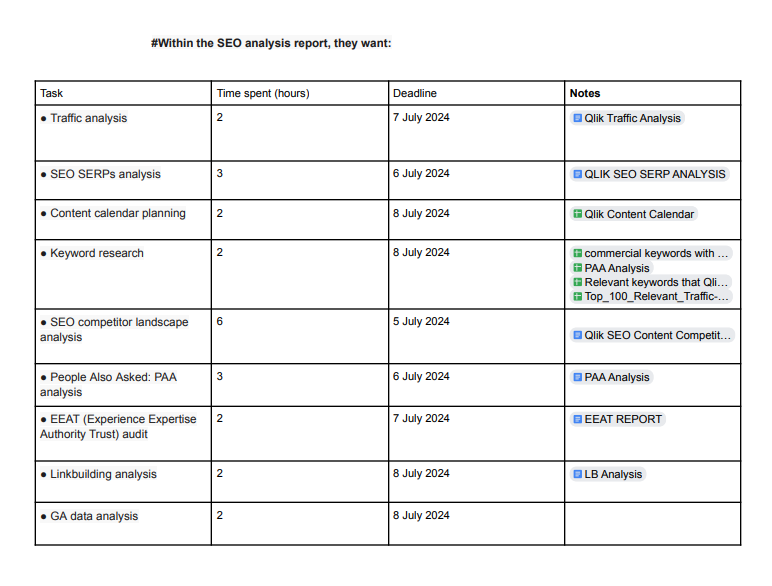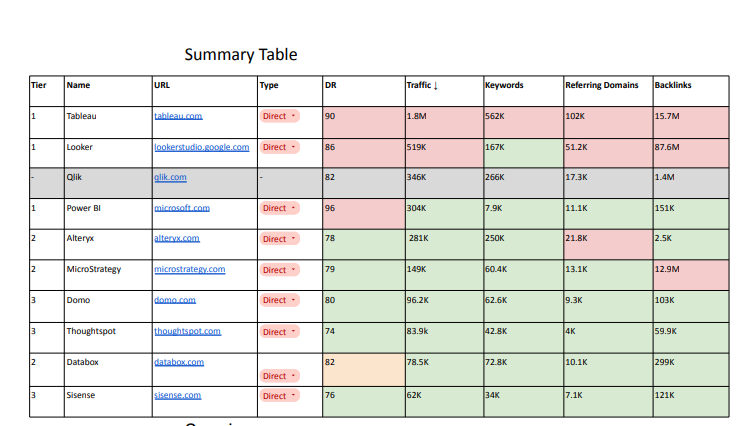Qlik SEO Analysis & Growth Strategy
- Keito Panaglima
- Aug 20
- 2 min read
Client Overview
Qlik is a global leader in data integration, quality, and analytics solutions, providing enterprise-level platforms that combine AI/ML with powerful business intelligence tools. Despite its strong market presence, Qlik was struggling with organic visibility compared to top competitors like Tableau and Power BI.
I was engaged to analyze Qlik’s SEO performance, identify gaps, and create a strategic roadmap to boost organic visibility, conversions, and authority in the highly competitive data analytics market.
Objectives
Align SEO strategy with Qlik’s business goals, including data integration, cloud analytics, and AI/ML adoption.
Improve organic traffic acquisition and search visibility in competitive SERPs.
Enhance content targeting for enterprise decision-makers.
Strengthen E-E-A-T (Experience, Expertise, Authoritativeness, Trustworthiness) to build credibility.
Reduce technical SEO issues such as 404 errors and broken backlinks.

Research & Analysis
1. Current SEO Performance
Qlik attracted 346K organic visits, ranking for 266K keywords.
Competitors like Tableau significantly outperformed Qlik with 1.8M visits and 562K ranked keywords.
Organic search was Qlik’s strongest acquisition channel with 143K+ monthly users, but conversion rates were low at 1.5% versus the industry average of 2–3%.

2. Competitor Benchmarking

Tableau excelled with multilingual SEO, an extensive blog and resource hub, and “jobs to be done” (JTBD) content.
Alteryx implemented a glossary-driven content strategy and industry-specific landing pages.
ThoughtSpot dominated analytics comparisons and visualization blogs.
Qlik lagged in multilingual presence, JTBD content, and role-specific pages, representing untapped growth opportunities.
3. Technical SEO Findings
The 404 error page was the site’s top-viewed page with 221K views in 28 days.
High-authority backlinks from Wikipedia, Azure Blog, and Google Cloud Blog were broken.
Missing hreflang tags caused multilingual SEO inefficiencies.
Key Recommendations


Content Strategy
Develop JTBD content (e.g., “How to integrate data using Qlik Talend Cloud”).
Create role-specific landing pages targeting Data Analysts, IT Managers, and Executives.
Expand comparison pages (e.g., “Qlik vs. Competitor”) to capture high-intent buyers.
Convert case studies from PDFs to SEO-friendly web pages.
Technical SEO Fixes
Resolve 404 errors using 301 redirects.
Recover broken backlinks from authoritative sources such as Wikipedia and Microsoft.
Add hreflang tags to enable proper regional targeting.
SERP Feature Optimization
Target Featured Snippets and People Also Ask for key queries like “data governance” (15K search volume).
Build FAQ-style content with schema markup to capture zero-click searches.
E-E-A-T Enhancements
Add author bios and expert commentary on blogs.
Display client logos, awards, and testimonials prominently.
Expand long-form blog posts to ~1,800–2,000 words for competitive queries.
Link Building
Scale high-quality backlinks via guest posting and industry collaborations.
Build resource-driven content such as guides, templates, and toolkits to attract natural links.
Possible Results & Outcomes (Projected)
By implementing this strategic roadmap, Qlik can expect:
50–70% growth in organic traffic within 6–12 months.
Recovery of link equity from high-authority backlinks (Domain Rating 90+).
Improved conversion rates from 1.5% to 2–3% through optimized calls-to-action.
Expanded global visibility through multilingual SEO enhancements.
Stronger brand authority aligned with E-E-A-T principles.
Conclusion
This project highlights my ability to conduct in-depth SEO analysis for enterprise SaaS clients, benchmark against industry leaders, and develop actionable, strategic plans. The recommendations I provided address Qlik’s technical, content, and authority gaps, laying the groundwork for increased market share and competitive positioning in the data analytics industry.
Feedback


Comments